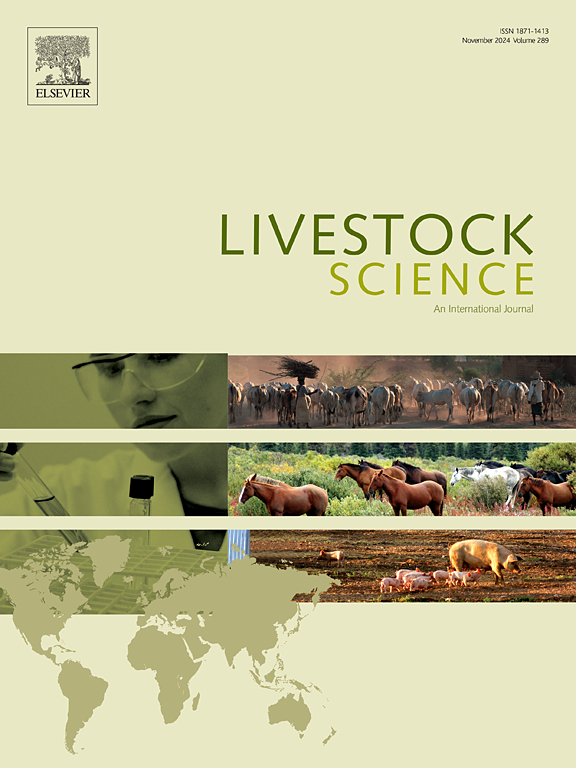Detection of anemic sheep using ocular conjunctiva images and deep learning algorithms
IF 1.9
3区 农林科学
Q2 AGRICULTURE, DAIRY & ANIMAL SCIENCE
引用次数: 0
Abstract
In sheep, severe anemia often results from gastrointestinal nematode infections, commonly caused by Haemonchus contortus, a blood-sucking nematode. The objective of this study was to develop a model to predict packed cell volume (PCV) in sheep through ocular conjunctiva images as a real-time anemia diagnosis approach. The dataset consisted of 3,441 ocular conjunctiva images collected from 392 sheep from three different farms using a smartphone camera. To identify the region of interest in the images (ocular conjunctiva), we annotated 480 images using the Segment Anything Model (SAM). Subsequently, we employed an image segmentation algorithm based on U-net, utilizing the original images and annotations obtained from SAM. We then cropped the segmented images to retain only the ocular conjunctiva region. These cropped and segmented images were used as input data, with PCV as the target variable, in both regression and classification models. We assessed the performance of three different deep neural network (DNN) architectures: VGG19, Inception v3, and Xception. For the classification tasks, a threshold of 27 % (anemic < 27 %, non-anemic ≥ 27 %) was used to convert PCV into a binary variable. The dataset was split into training, validation, and testing sets using random sampling by sheep. The segmentation was evaluated using intersection over union (IoU). To compare the predictive quality in the testing set, we computed the R2, Concordance Correlation Coefficient (CCC), and Root Mean Square Error of Prediction (RMSEP) for the regression models, and the accuracy, precision, recall, and F1 score for the classification tasks. The U-net segmentation model demonstrated reliable segmentation ability, with an average IoU of 0.93, 0.84, and 0.68 in the training, validation, and testing sets, respectively. For regression, the Xception architecture provided the best performance with an R2 of 0.24. For the classification models, VGG19 outperformed the other models in classifying individuals as anemic or non-anemic, achieving an F1 score of 0.62, indicating its moderate ability to distinguish between these two classes. This innovative approach not only expands the possibilities for integrated high-throughput phenotyping through computer vision, but also aids in identifying anemic animals. The results suggest that integrating ocular conjunctiva images with DNN algorithms can contribute to supporting farm-level management decisions, and potentially reduce economic losses due to parasitic infections like H. contortus. Furthermore, this approach not only facilitates real-time anemia diagnosis but also optimizes the use of blood tests, potentially reducing associated costs.
利用眼结膜图像和深度学习算法检测贫血羊
在绵羊中,严重贫血通常是由胃肠道线虫感染引起的,通常是由一种吸血线虫——扭曲血线虫引起的。本研究的目的是建立一种通过眼结膜图像预测绵羊堆积细胞体积(PCV)的模型,作为一种实时贫血诊断方法。该数据集包括使用智能手机相机从三个不同农场的392只羊身上收集的3,441张眼结膜图像。为了识别图像中感兴趣的区域(眼结膜),我们使用分段任意模型(SAM)对480幅图像进行了注释。随后,我们采用了基于U-net的图像分割算法,利用原始图像和从SAM中获得的注释。然后我们裁剪分割图像,只保留眼结膜区域。这些裁剪和分割的图像作为输入数据,以PCV为目标变量,用于回归和分类模型。我们评估了三种不同深度神经网络(DNN)架构的性能:VGG19、Inception v3和Xception。对于分类任务,阈值为27%(贫血<;27%,非贫血≥27%)将PCV转化为二元变量。数据集被分成训练集、验证集和测试集,使用羊随机抽样。使用交比联合(IoU)对分割进行评估。为了比较测试集中的预测质量,我们计算了回归模型的R2、一致性相关系数(CCC)和预测均方根误差(RMSEP),以及分类任务的准确率、精密度、召回率和F1分数。U-net分割模型显示出可靠的分割能力,在训练集、验证集和测试集的平均IoU分别为0.93、0.84和0.68。对于回归,Xception架构提供了最好的性能,R2为0.24。在分类模型中,VGG19在将个体划分为贫血或非贫血方面优于其他模型,F1得分为0.62,表明其区分这两类的能力中等。这种创新的方法不仅扩大了通过计算机视觉进行综合高通量表型分析的可能性,而且有助于识别贫血动物。研究结果表明,将眼结膜图像与深度神经网络算法相结合,有助于支持农场层面的管理决策,并有可能减少因弓形虫等寄生虫感染造成的经济损失。此外,这种方法不仅促进了实时贫血诊断,还优化了血液检查的使用,潜在地降低了相关成本。
本文章由计算机程序翻译,如有差异,请以英文原文为准。
求助全文
约1分钟内获得全文
求助全文
来源期刊

Livestock Science
农林科学-奶制品与动物科学
CiteScore
4.30
自引率
5.60%
发文量
237
审稿时长
3 months
期刊介绍:
Livestock Science promotes the sound development of the livestock sector by publishing original, peer-reviewed research and review articles covering all aspects of this broad field. The journal welcomes submissions on the avant-garde areas of animal genetics, breeding, growth, reproduction, nutrition, physiology, and behaviour in addition to genetic resources, welfare, ethics, health, management and production systems. The high-quality content of this journal reflects the truly international nature of this broad area of research.
 求助内容:
求助内容: 应助结果提醒方式:
应助结果提醒方式:


